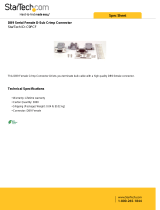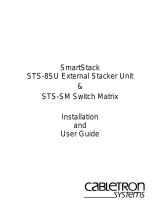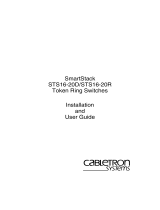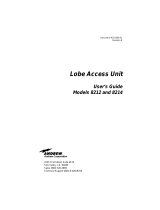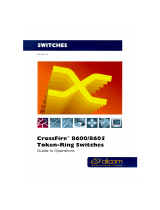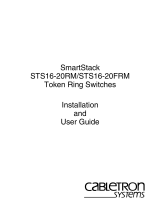Page is loading ...

StackMaster TR
Active Retiming Managed Hub
SMHB-TR-16
#7361.C
™

CAUTION: RJ connectors are NOT INTENDED FOR
CONNECTION TO THE PUBLIC TELEPHONE NETWORK.
Failure to observe this caution could result in damage to the
public telephone network.
Compliance Information
UL Listed
C-UL Listed (Canada)
CISPR/EN55022 Class A
FCC Regulations
This equipment has been tested and found to comply with the limits for a class
A digital device, pursuant to part 15 of the FCC rules. These limits are
designed to provide reasonable protection against harmful interference when
the equipment is operated in a commercial environment. This equipment
generates, uses, and can radiate radio frequency energy and, if not installed
and used in accordance with the instruction manual, may cause harmful
interference to radio communications. Operation of this equipment in a
residential area is likely to cause harmful interference, in which case the user
will be required to correct the interference at the user’s own expense.
Canadian Regulations
This digital apparatus does not exceed the Class A limits for radio noise for
digital apparatus set out on the radio interference regulations of the Canadian
Department of Communications.
European Regulations
Warning
This is a Class A product. In a domestic environment this product may cause
radio interference in which case the user may be required to take adequate
measures.
Copyright Restrictions
© 1995, 1996 TRANSITION Networks Inc.
All rights reserved. No part of this work may be reproduced or used in any
form or by any means – graphic, electronic, or mechanical – without written
permission from TRANSITION Networks Inc.
Trademark Notice
All registered trademarks and trademarks are the property of their respective
owners.
Der Anschluss dieses Gerätes an ein öffentlickes
Telekommunikationsnetz in den EG-Mitgliedstaaten verstösst gegen die
jeweligen einzelstaatlichen Gesetze zur Anwendung der Richtlinie
91/263/EWG zur Angleichung der Rechtsvorschriften der
Mitgliedstaaten über Telekommunikationsendeinrichtungen
einschliesslich der gegenseitigen Anerkennung ihrer Konformität.

Table of Contents
Preface . . . . . . . . . . . . . . . . . . . . . . . . . . . . . . . . . . . . . . . . . . . . . . . . . . . . iii
1. INTRODUCTION . . . . . . . . . . . . . . . . . . . . . . . . . . . . . . . . . . . . . . . . . . . . 1–1
2. SITE PLANNING . . . . . . . . . . . . . . . . . . . . . . . . . . . . . . . . . . . . . . . . . . . . . 2–1
2.1 Site Considerations. . . . . . . . . . . . . . . . . . . . . . . . . . . . . . . . . . . . . . . 2–1
2.2 Network Parameters Data Sheets . . . . . . . . . . . . . . . . . . . . . . . . . . . .2–2
TCP/IP Network Parameters Data Sheet . . . . . . . . . . . . . . . . . . . . 2-2
SNMP Network Parameters Data Sheet. . . . . . . . . . . . . . . . . . . . . 2-3
Serial Port Parameters Data Sheet. . . . . . . . . . . . . . . . . . . . . . . . . 2-4
3. INSTALLATION . . . . . . . . . . . . . . . . . . . . . . . . . . . . . . . . . . . . . . . . . . . . .3–1
3.1 Unpacking StackMaster™TR Equipment . . . . . . . . . . . . . . . . . . . . . . .3–1
3.2 Stacking Units in Rack or on Table . . . . . . . . . . . . . . . . . . . . . . . . . . .3–2
3.2.1 Standard 19-Inch Rack Installation . . . . . . . . . . . . . . . . . . . . . . .3–2
3.2.2 Table-Top Installation . . . . . . . . . . . . . . . . . . . . . . . . . . . . . . . .3–3
3.3 Cascading StackMaster™TR Units . . . . . . . . . . . . . . . . . . . . . . . . . . .3–4
3.4 Connecting StackMaster™TR to Token Ring Network . . . . . . . . . . . .3–5
3.5 Connecting Units to Power . . . . . . . . . . . . . . . . . . . . . . . . . . . . . . . . .3–6
3.6 Resetting StackMaster™TR Stack . . . . . . . . . . . . . . . . . . . . . . . . . . . .3–7
Managed Stack . . . . . . . . . . . . . . . . . . . . . . . . . . . . . . . . . . . . . . .3–7
Unmanaged Stack . . . . . . . . . . . . . . . . . . . . . . . . . . . . . . . . . . . .3–7
3.7 Optionally Configuring SNMP Management at Attached Terminal . .3–8
3.7.1 Connecting to ASCII Terminal . . . . . . . . . . . . . . . . . . . . . . . . . .3–8
3.7.2 Bringing Up Configuration Software . . . . . . . . . . . . . . . . . . . . .3–9
3.7.4 Setting Network and SNMP Parameters . . . . . . . . . . . . . . . . . .3–10
Network Parameters . . . . . . . . . . . . . . . . . . . . . . . . . . . . . . . . . .3–10
SNMP Parameters . . . . . . . . . . . . . . . . . . . . . . . . . . . . . . . . . . .3–11
3.7.3 Resetting the StackMaster™TR . . . . . . . . . . . . . . . . . . . . . . . . .3–12
4. OPERATION . . . . . . . . . . . . . . . . . . . . . . . . . . . . . . . . . . . . . . . . . . . . . . . .4–1
4.1 Power On/Power Off . . . . . . . . . . . . . . . . . . . . . . . . . . . . . . . . . . . . .4–1
5. MAINTENANCE . . . . . . . . . . . . . . . . . . . . . . . . . . . . . . . . . . . . . . . . . . . . .5–1
5.1 Fault Isolation . . . . . . . . . . . . . . . . . . . . . . . . . . . . . . . . . . . . . . . . . . .5–1
5.2 Recovery Procedures . . . . . . . . . . . . . . . . . . . . . . . . . . . . . . . . . . . . .5–4
Resetting the StackMaster™TR . . . . . . . . . . . . . . . . . . . . . . . . . . . . . .5-4
i
User’s Guide

5.3 Replacement Procedures . . . . . . . . . . . . . . . . . . . . . . . . . . . . . . . . . .5–5
Replacing StackMasterTR Unit Fuses . . . . . . . . . . . . . . . . . . . . . . . . .5–5
5.4 StackMasterTR Field Upgrades . . . . . . . . . . . . . . . . . . . . . . . . . . . . . .5–6
Installing SNMP Management Board . . . . . . . . . . . . . . . . . . . . . . . . . .5–6
5.5 Software Upgrades . . . . . . . . . . . . . . . . . . . . . . . . . . . . . . . . . . . . . . .5–9
Software Upgrade at Attached ASCII Terminal . . . . . . . . . . . . . . . . . .5–9
Obtaining Updated StackMaster™TR Software . . . . . . . . . . . . . . .5–9
Connecting to ASCII Terminal . . . . . . . . . . . . . . . . . . . . . . . . . . .5–9
Resetting the StackMasterTR . . . . . . . . . . . . . . . . . . . . . . . . . . . .5–10
Transferring the File . . . . . . . . . . . . . . . . . . . . . . . . . . . . . . . . . .5–10
ii
StackMasterTR

Preface
This guide is intended for the system or network administrator responsible
for installing, configuring, using, and maintaining a Transition Engineering
StackMaster™TR. A working knowledge of local area network (LAN) oper-
ations, including familiarity with communications protocols used on inter-
connected LANs, is assumed.
iii
User’s Guide


1. Introduction
The TRANSITION Networks 16-Port StackMaster™TR Active Retiming
Managed Hubs are designed for building SNMP managed token ring LANs
using twisted pair cable.
The StackMaster™TR Managed Hub:
• Complies with current IEEE 802.5 token ring standards to ensure
interoperability
• Supports external SNMP network management
• Provides sixteen RJ-45 lobe ports support both STP and UTP
• Provides active signal retiming and regeneration on a per port basis
maximizes lobe and RI/RO cable runs
• Supports Category 3, 4 or 5 UTP/STP and IBM Type 1 Cable
• Allows 4 or 16 Mbps operation
• Allows RI/RO connection to both “active hubs” and “passive hubs”
• Delivers fault-tolerant, automatic ring wrap capability at RI/RO
• Provides Zero Delay Lockout, automatic lockout of station configured
at wrong speed
• Installed as standalone or rackmount in a standard 19” rackmount
frame.
• Provides serial port connection for Out of Band management.
NOTE: The StackMaster™TR 16-Port Hub is designed to support an
Active Retime environment with HOT SWAP capability. An active hub
can be added or removed without bringing the network down.
USER’S GUIDE
1-1
1 2 3 4 5 6 7 8 9 10 11 12 13 14 15 16
Lobe Ports
Active Retiming Managed Hub
Insert
Normal
Power
Ring Out
4 Mbps
P
A
16 Mbps
Reset
™
16 Port StackMaster TR
ZDL
OFF
ON
123 4
5
6
78
Expansion Card
Indicators
Enable
Status
Ring In
P
A
networks
TRANSITION

Connectors
Ring In/Ring Out Connector
An RJ-45 Ring In connector and an RJ-45 Ring Out connector are
provided at the front of the 16-Port StackMaster™TR Active Retiming
Managed Hub.
Lobe Connectors
Sixteen (16) RJ-45 lobe connectors are provided at the front of the 16-Port
StackMaster™TR Active Retiming Managed Hub.
1-2
StackMaster™TR
Ring In
R ing Out
1 2 3 4 5 6 7 8 9 10 11 12 13 14 15 16
Lobe Ports
Active Retiming Managed Hub
Insert
Normal
Power
Ring Out
4 Mbps
P
A
16 Mbps
Reset
™
16 Port StackMaster TR
ZDL
OFF
ON
123 4
5
6
78
Expansion Card
Indicators
Enable
Status
Ring In
P
A
networks
TRANSITION
1 2 3 4 5 6 7 8 9 10 11 12 13 14 15 16
Lobe Ports
Active Retiming Managed Hub
Insert
Normal
Power
Ring Out
4 Mbps
P
A
16 Mbps
Reset
™
16 Port StackMaster TR
ZDL
OFF
ON
123 4
5
6
78
Expansion Card
Indicators
Enable
Status
Ring In
P
A
networks
TRANSITION

Connectors at Back
A serial port connector for SNMP management and maintenance, two (2)
Cascade (bus) connectors, and a power connector are provided at the
back of the StackMaster™TR 16-Port.
NOTE: The AUX connector is intended for future development.
11.. IINNTTRROODDUUCCTTIIOONN
USER’S GUIDE
1-3
Caution : For continued protection against risk of fire, replace only
with same type and rating of fuse : 250V 2A.
Caution : Disconnect power before replacing fuse.
ATTENTION: Couper le courant avant de replacer le fusible.
2A, 250V
Input Power: 100-240 V
50/60 Hz
0.5 A
Model#: SMHB-TR-16
Mpls, MN 55344
A
B
Cascade Connectors
Serial AUX
Achtung!: Zum anhaltenden Schutz vor Feurgefahr, Sicherung nur
mit einer gleichnamiger Stromstarke und Spannung
ersetzen: 250V, 2A
Achtung!: Stromleitung ausschalten bevor Sicherung ersetzen!
networks
TRANSITION
Serial
Cascade (Bus) Connectors
Power Connector

Indicators
Power LED
When the StackMaster™TR 16-Port Unit is powered, the Power indicator
is illuminated.
Insert/Normal LEDs
The Insert LED (above the Ring In port) is illuminated if the
StackMaster™TR 16-Port RI port is connected to the RO port of a hub.
NOTE: When the RI switch is in the passive position, the LED always is
ON, indicating that the RI port is configured in the passive mode.
The Normal LED (above the Ring Out port) is illuminated if the
StackMaster™TR 16-Port RO port is connected to the RI port of a hub
which is powered.
NOTE: When the RO switch is in the passive position, the LED always is
ON, indicating that the RO port is configured in the passive mode.
1-4
StackMaster™TR
Power
1 2 3 4 5 6 7 8 9 10 11 12 13 14 15 16
Lobe Ports
Active Retiming Managed Hub
Insert
Normal
Power
Ring Out
4 Mbps
P
A
16 Mbps
Reset
™
16 Port StackMaster TR
ZDL
OFF
ON
123 4
5
6
78
Expansion Card
Indicators
Enable
Status
Ring In
P
A
networks
TRANSITION
1 2 3 4 5 6 7 8 9 10 11 12 13 14 15 16
Lobe Ports
Active Retiming Managed Hub
Insert
Normal
Power
Ring Out
4 Mbps
P
A
16 Mbps
Reset
™
16 Port StackMaster TR
ZDL
OFF
ON
123 4
5
6
78
Expansion Card
Indicators
Enable
Status
Ring In
P
A
networks
TRANSITION
Normal
Insert

Port Status LEDs
Port Status LEDs above each of the sixteen (16) RJ-45 lobe port
connectors indicate insertion status for each of the sixteen connections:
green LED: good insertion
NOTE: Illuminated LEDs indicate insertion EXCEPT when a wrong speed
station is plugged into the hub; when a wrong speed station is plugged
into the hub, the iluminated LED indicates only that the connecting cable
is good.
Management Board LEDs
When the SNMP Management circuit board is installed and managing the
StackMaster™TR 16-Port Stack, the SNMP Management circuit board
indicators are active. The Enable indicator is illuminated when the SNMP
Management circuit board is installed. The eight Management Status
indicators cycle in a steady roll when the StackMaster™TR 16-Port Stack
is functioning normally.
11.. IINNTTRROODDUUCCTTIIOONN
USER’S GUIDE
1-5
1 2 3 4 5 6 7 8 9 10 11 12 13 14 15 16
Lobe Ports
Active Retiming Managed Hub
Insert
Normal
Power
Ring Out
4 Mbps
P
A
16 Mbps
Reset
™
16 Port StackMaster TR
ZDL
OFF
ON
123 4
5
6
78
Expansion Card
Indicators
Enable
Status
Ring In
P
A
networks
TRANSITION
11 12
1 2 3 4 5 6 7 8 9 10 11 12 13 14 15 16
Lobe Ports
Active Retiming Managed Hub
Insert
Normal
Power
Ring Out
4 Mbps
P
A
16 Mbps
Reset
™
16 Port StackMaster TR
ZDL
OFF
ON
123 4
5
6
78
Expansion Card
Indicators
Enable
Status
Ring In
P
A
networks
TRANSITION
Enable
1
2
3
4
5
6
7
8
Status

Switches
Active/Passive Switches
A(ctive) and P(assive) switches are provided for the Ring In port and for
the Ring Out port for connection to active ( “A” ) or to passive (“P”) hubs.
ZDL Switch
The ZDL Switch allows selection of automatic speed detection. NOTE:
The default position is ON. The OFF position is used for connecting non-
802.5 compliant equipment, such as the Hewlet Packard token ring tester.
NOTE: The StackMaster™TR 16-Port Hub must be reset when the ZDL
switch position is changed.
Reset Switch
A reset switch is located on the front of the StackMaster™TR 16-Port Hub.
The reset switch reinitializes the StackMaster™TR 16-Port Unit. If the
SNMP Management Board is installed in the StackMaster™TR 16-Port
Unit and the StackMaster™TR 16-Port Unit is installed at the top of a
Stack, the reset switch reinitializes the entire Stack.
1-6
StackMaster™TR
1 2 3 4 5 6 7 8 9 10 11 12 13 14 15 16
Lobe Ports
Active Retiming Managed Hub
Insert
Normal
Power
Ring Out
4 Mbps
P
A
16 Mbps
Reset
™
16 Port StackMaster TR
ZDL
OFF
ON
123 4
5
6
78
Expansion Card
Indicators
Enable
Status
Ring In
P
A
networks
TRANSITION
P
A
P
A
OFF
ON
ZDL
1 2 3 4 5 6 7 8 9 10 11 12 13 14 15 16
Lobe Ports
Active Retiming Managed Hub
Insert
Normal
Power
Ring Out
4 Mbps
P
A
16 Mbps
Reset
™
16 Port StackMaster TR
ZDL
OFF
ON
123 4
5
6
78
Expansion Card
Indicators
Enable
Status
Ring In
P
A
networks
TRANSITION
Reset
1 2 3 4 5 6 7 8 9 10 11 12 13 14 15 16
Lobe Ports
Active Retiming Managed Hub
Insert
Normal
Power
Ring Out
4 Mbps
P
A
16 Mbps
Reset
™
16 Port StackMaster TR
ZDL
OFF
ON
123 4
5
6
78
Expansion Card
Indicators
Enable
Status
Ring In
P
A
networks
TRANSITION

4Mbps/16Mbps Switch
The 4Mbps/16Mbps Speed Selection Switch allows selection of data rate
(4Mbps or 16Mbps).
NOTE: The StackMaster™TR 16-Port Hub must be reset when the
4Mbps/16Mbps switch position is changed.
NOTE: Network speed affects maximum twisted pair cable distances.
11.. IINNTTRROODDUUCCTTIIOONN
USER’S GUIDE
1-7
1 2 3 4 5 6 7 8 9 10 11 12
13
14 15 16
R OR I
4
16
Up to 300 m
with Category 5
UTP
Up to 100 m
with Category 3
UTP
Up to 400 m
with Category 5
STP
1 2 3 4 5 6 7 8 9 10 11 12
13
14 15 16
R OR I
4
16
Speed: 16 Mbps
networks
TRANSITION
networks
TRANSITION
1 2 3 4 5 6 7 8 9 10 11 12
13
14 15 16
R OR I
4
16
Up to 500 m
with Category 5
UTP
Up to 300 m
with Category 3
UTP
Up to 500 m
with Category 5
STP
1 2 3 4 5 6 7 8 9 10 11 12
13
14 15 16
R OR I
4
16
Speed: 4 Mbps
networks
TRANSITION
networks
TRANSITION
4 Mbps
16 Mbps
1 2 3 4 5 6 7 8 9 10 11 12 13 14 15 16
Lobe Ports
Active Retiming Managed Hub
Insert
Normal
Power
Ring Out
4 Mbps
P
A
16 Mbps
Reset
™
16 Port StackMaster TR
ZDL
OFF
ON
123 4
5
6
78
Expansion Card
Indicators
Enable
Status
Ring In
P
A
networks
TRANSITION


2. Site Planning
Site planning for the StackMasterTR Stack requires consideration both of
site conditions and of token ring standards.
2.1 Site Considerations
The site for the StackMasterTR Token Ring Stack must provide the
following:
• AC power outlet for each StackMasterTR Unit
• Adequate ventilation
• Standard environmental conditions
• Isolation from electrical noise, including radio transmitters and
broadbank amplifiers, motors, high power electrical lines, or
fluorescent light fixtures
Additionally:
• The token ring cables should not run in the same conduit with power
line cables.
• Phone lines should be separated from data cables.
• Flat or “silver satin” wires should not be used.
2-1
USER’S GUIDE

2.2 Network Parameters Data Sheets
NOTE: SNMP network management is optional.
The network parameter data sheets are intended to be a permanent record
of site-specific network parameter values that will be required for
configuring SNMP network management.
TCP/IP Network Parameters Data Sheet
CATEGORY StackMasterTR DEFAULT SITE ENTRY
IP address (ipaddr)
Management station
192.251.144.253
to which asynchronous
SNMP reports will be sent.
Format: xxx.xxx.xxx.xxx
EXAMPLE: 192.251.144.253
Subnet mask (submask)
Format: xxx.xxx.xxx.xxx 255.255.255.224
EXAMPLE: 255.255.255.224
Router (router)
Site-specific identifier. 0.0.0.0
Format: x.x.x.x
EXAMPLE:
0.0.0.0
Name (name)
Site-specific identifier NONE
Format: up to 256 characters
EXAMPLE:
NONE
Domain (domain)
Site-specific identifier.
NONE
Format: up to 256 characters
EXAMPLE:
NONE
Name of server
(nameserver)
Site-specific identifier 0.0.0.0
Format: x.x.x.x
EXAMPLE:
0.0.0.0
Table 2-1. TCP/IP Network Parameters Data Sheet
StackMaster™TR
2-2

SNMP Network Parameters Data Sheet
CATEGORY StackMasterTR DEFAULT SITE ENTRY
(commwrite)
Security permission PRIVATE
Format: PRIVATE/PUBLIC
Authorization (auth)
Security identifier DISABLE
Format: DISABLE/ENABLE
System name (sysname)
Site-specific identifie -- usually. NONE
the host name.
Format: Up to 256 characters
Location (location)
Site-specific identifie -- usually. NONE
the host name.
Format: Up to 256 characters
(commread)
Security permission PUBLIC
Format: PRIVATE/PUBLIC
Location for SNMP
messages (trap) 0.0.0.0
Format: x.x.x.x
EXAMPLE:
0.0.0.0
(contact)
Site-specific identifier NONE
Format: Up to 256 characters
Table 2-2. SNMP Network Parameters Data Sheet
22.. SSIITTEE PPLLAANNNNIINNGG
2-3
USER’S GUIDE

Serial Port Parameters Data Sheet
CATEGORY StackMasterTR DEFAULT SITE ENTRY
Transmission rate (bps)
Transmission speed, in bits 9600
per second
Format: 9600/
Name (stop bitse)
Serial protocol definition entry. 1
Format: NONE/1
(data bits)
Serial protocol definition entry. 8
Format: NONE/1
(parity)
Optional error checking entry NONE
Format: NONE/1
Table 2-3. Serial Port Parameters Data Sheet
StackMaster™TR
2-4

3. Installation
To install the StackMaster™TR 16-Port Active Retiming Managed Hub::
• Unpack the StackMaster™TR Equipment
• Stack Units in Rack or on Table
• Cascade StackMaster™TR Units
• Connect StackMaster™TR to Network
• Connect Units to Power
• Optionally Configure SNMP Network Management
3.1 Unpacking StackMaster™TR 16-Port Equipment
Use the packing contents lists to verify the shipment:
Item Part Number
StackMaster Modular Chassis SMHB-TR-16
Special 6-inch DB-25 data cable 6005
Power Cord 3344 (or refer to Appendix D)
User’s Guide 7361
3-1
USER’S GUIDE

3.2 Stacking Units in Rack or on Table
NOTE: StackMaster™TR 16-Port Units are shipped with attached brackets
for standard 19-inch rack installation and with attachable feet for table-top
installation.
3.2.1 Standard 19-Inch Rack Installation
CAUTION: The StackMaster™TR 16-Port Unit with the SNMP
Management Board must be installed at the top of the stack. Failure to
observe this caution will invalidate the SNMP network management.
NOTE: Rackmount screws and clip nuts are NOT provided with the
StackMaster™TR 16-Port Units.
To install the StackMaster™TR 16-Port Stack in a standard 19-inch rack:
1. Locate four (4) screws (and clip nuts, if necessary) for each
StackMaster™TR 16-Port Unit to be installed.
2. Locate the StackMaster™TR 16-Port Unit to be installed at the
bottom of the stack.
3. Carefully align the StackMaster™TR 16-Port Unit between the 19-
inch rack mounting rails at the lowest installation position.
4. Install two screws through right front bracket and two screws
through left front bracket, using clip nuts if necessary.
5. Carefully align the next StackMaster™TR 16-Port Unit above the
StackMaster™TR 16-Port Unit already installed.
6. Repeat steps 4 and 5 in reverse order until all StackMaster™TR
16-Port Units have been installed.
StackMasterTR
3-2
/
